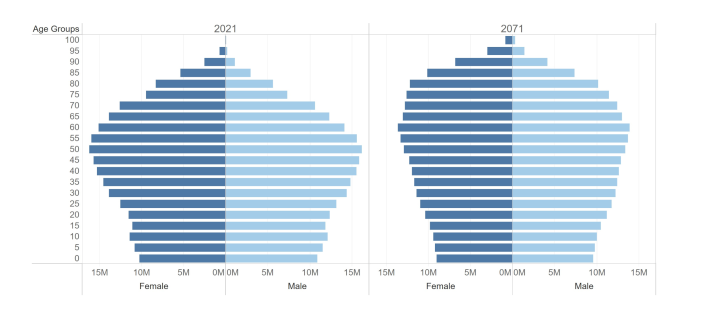
A JRC study applies an innovative model to estimate the healthcare workforce needed in the EU until 2071, while taking into account current and future turnover of health professionals, demographic change and healthy ageing. Based on data from 2021, the model allows to make projections for a period of 50 years at individual country and EU level.
The study Healthcare workforce demand and supply in the EU27 can help national authorities across EU countries to anticipate needs and plan staffing of healthcare services in the long-term to address the demographic challenges of the ageing EU population and the healthcare workforce.
The ageing population in Europe is driving an increased demand for healthcare services, with the proportion of citizens aged 65 and over expected to rise noticeably in the coming decades. This demographic shift, coupled with the concurrent shrinking of the working-age population, is placing an unprecedented strain on healthcare systems.
How will the demand for healthcare professionals evolve?
The results of the study reveal a complex landscape where the demand of doctors and nurses is expected to increase by 2071 due to the ageing of the population, if the health service utilisation and disease prevalence burden remain the same as in 2021.
The study indicates that if the number of doctors and nurses entering and leaving the profession remains similar to 2021, the number of doctors in the EU would increase by 16% and the number of nurses would increase by 8% by 2071. However, this increase would still fall short of the demand if we consider the ageing of the population, together with trends in public health and the use of public health services.
The projections indicate that the number of doctors would need to increase by 30% and the number of nurses by 33% to meet the demand, if disease burden remains constant. This demand would decrease considerably in healthy ageing scenarios, where people are in good health in later stages of their lives.
The study shows that if the burden of certain diseases continues to decrease as in the past, it could more than offset the consequences of an ageing population, leading to a reduced need for doctors and nurses in the future. In this regard, the study highlights the important role of healthy ageing in reducing the burden on doctors and nurses while improving the well-being of people in general.
To respond to an increasing demand, the number of newly recruited professionals would need to increase, especially in the short run. This means that in the coming years, the number of doctors/nurses leaving the labour force will need to be compensated by a larger number of new doctors/nurses entering the profession.
Examples from across the EU
For instance, countries such as Italy, Estonia and Luxemburg will need to double the recruitment of new doctors. In Italy, the largest age group of doctors in 2021 (about 19%) was aged 65-69 years old, close to retirement. The situation was similar in Germany, although to a lesser extent, as the largest age groups of doctors were 55-60 and 60-64 (21% and 16% respectively). In Sweden there was a more uniform distribution across age groups.
This contrasts with countries such as Ireland, Cyprus and Finland, where the number of younger doctors was higher. In 2021, the largest age group of doctors in Ireland was 35-39 years old. In Cyprus, it was the 40-44 age group, while in Finland it was the 30-39 age group.
In countries like Sweden and Denmark, the current number of new doctors would be sufficient to compensate for retirements in the short term. However, taking into consideration an increasing demand for health services, the number of new doctors will need to increase.
What could national authorities do?
The study also serves as a call for EU Member States to adopt a forward-looking approach to healthcare workforce planning. The findings highlight the need for EU Member States to align healthcare policies with demographic strategies, tailoring them to national conditions, and engaging a diverse group of stakeholders in the process.
The analysis shows that the challenges of an ageing EU population can be addressed effectively, ensuring that all citizens have access to quality healthcare services, one of the key objectives of Sustainable Development Goal 3 by 2030. The European Commission supports Member States through a range of initiatives, including the EU4Health programme, the BeWell skills development project, digital competency programmes, and initiatives aimed at enhancing the recruitment and retention of nurses.
The SANDEM model
The study is based on a new model, the Supply ANd DEMand model for healthcare workforce (SANDEM). It includes the demographic characteristics of EU’s doctors and nurses as well as aspects that may influence the future demand for healthcare, such as the burden of different diseases but also the healthy ageing of the EU population.
The aim of the model is to complement national healthcare workforce planning with a long-term EU perspective under different scenarios. This work comes in the context of other studies focusing on enhancing workforce planning, such as the Joint Action HEalth woRkfOrce to meet health challEngeS (HEROES) and the OECD 2024 Health at a Glance project, which highlight challenges in this sector related to the retention, recruitment, reskilling and redistribution of doctors and nurses. This collaborative effort helps to improve the overall workforce management and resource allocation within the EU and the 27 MS.
Related links
Healthcare workforce demand and supply in the EU27
Supply AND DEMand model for the healthcare workforce in the EU27. Data sources and model structure
Enhancing EU healthcare workforce projections for sustainable health systems
The HEROES (HEalth woRkfOrcE to meet health challengeS) Joint Action
Details
- Publication date
- 6 December 2024
- Author
- Joint Research Centre
- JRC portfolios






